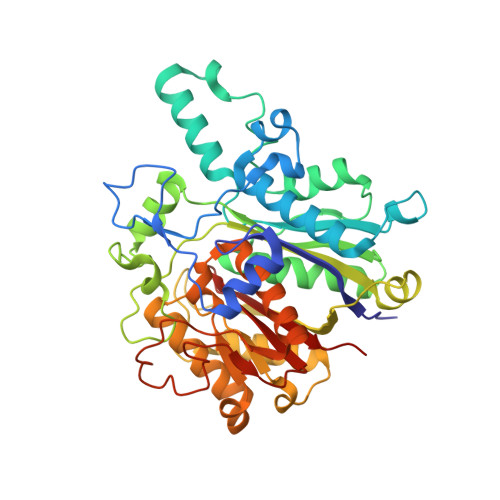Towards new antibiotics: P. aeruginosa FabF ligands discovered by crystallographic fragment screening followed by hit expansion.
Georgiou, C., Espeland, L.O., Bukya, H., Yadrykhins'ky, V., Haug, B.E., Mainkar, P.S., Brenk, R.(2025) Eur J Med Chem 291: 117563-117563
- PubMed: 40233425
- DOI: https://doi.org/10.1016/j.ejmech.2025.117563
- Primary Citation of Related Structures:
5SN5, 5SN6, 5SN7, 5SN8, 5SN9, 5SNA, 5SNB, 5SNC, 5SND, 5SNE, 5SNF, 5SNG, 5SNH, 5SNI, 5SNJ, 5SNK, 5SNL, 5SNM, 5SNN, 5SNO, 5SNP, 5SNQ, 5SNR, 5SNS, 5SNT, 5SNU, 5SNV, 5SNW, 5SNX, 5SNY, 5SNZ, 5SO0, 5SO1, 5SO2, 5SO3, 5SO4, 5SO5, 5SO6, 5SO7, 5SO8, 5SO9, 5SOA, 5SOB, 5SOC, 5SOD, 5SOE, 5SOF, 5SOG, 5SOH, 8CN2 - PubMed Abstract:
There is an urgent need for new antibiotics. FabF (3-oxoacyl-[acyl-carrier-protein] synthase 2), which catalyses the rate limiting condensation reaction in the fatty acid synthesis II pathway, is an attractive target. Very few inhibitors of FabF are known and most are derived from natural products. In an effort to further explore the chemical space of FabF ligands, we have carried out fragment screening by X-ray crystallography against an intermediated state-mimicking variant of P. aeruginosa FabF (PaFabF C164Q). This screen has resulted in 48 hits out of which 16 bind in or close to the malonyl-CoA or fatty acid binding site or an adjacent dimer interface. None of the closer investigated fragments were active in a binding assay, but the same was the case for fragments derived from a potent FabF inhibitor. For hit optimization, we focused on the two fragments binding close to the catalytic residues of FabF. Different strategies were followed in the optimization process: exploration of commercially available analogues, fragment merging, virtual screening of a combinatorial make-on-demand space, and design and in-house synthesis of analogues. In total, more than 90 analogues of the hit compounds were explored, and for 10 of those co-crystal structures could be determined. The most potent ligand was discovered using manual structure-based design and has a binding affinity of 65 μM. This data package forms a strong foundation for the development of more potent and diverse FabF inhibitors.
- Department of Biomedicine, University of Bergen, Jonas Lies Vei 91, 5020 Bergen, Norway.
Organizational Affiliation:



















